Research Topics access
Flood- and drought-adaptive Cropping Systems to Conserve Water Environments in Semi-arid Regions
Project SiteF Faculty of Agriculture & Natural Resources, Ogongo Campus,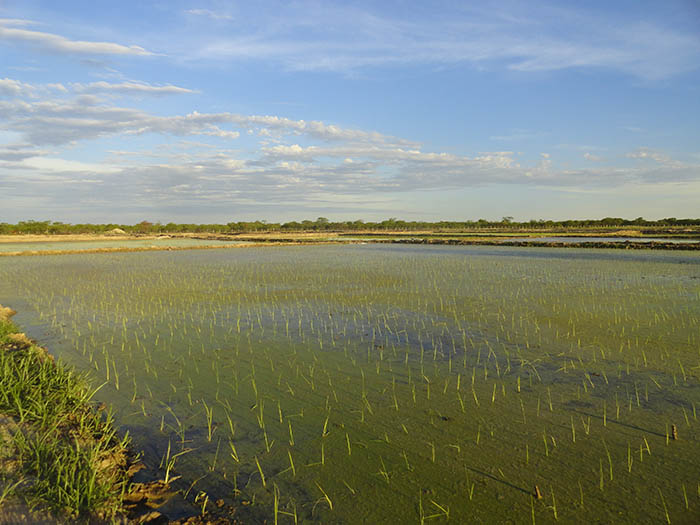
The University of Namibia and seasonal wetlands in northern Namibia
Target Group: Researchers of Faculty of Agriculture & Natural Resources,
The University of Namibia, and farmers in northern Namibia
Project DurationFJanuary 2012 - December 2016 i5 yearsj
Overall Goal
1. gFlood- and drought-adaptive cropping systemh is disseminated in north-central Namibia to contribute to the food security and cash income of local farmers.
2. g Flood- and drought-adaptive cropping systemh is considered in the northeastern area of Namibia of high rainfall as well as in neighboring countries.
(gFlood- and drought-adaptive cropping systemh: The farming system which secures food crop production by the subsistent farmers in both flood and drought years by mixed cropping of rice and pearl millet.)
Project Purpose
gFlood- and drought-adaptive cropping systemh is proposed that can sustainably preserve the water environment of semi-arid region.
Output
1FyCrop Sciencez The rice-pearl millet mixed cropping system which is balanced with the sustainable water conservation of seasonal wetland in semi-arid region is established.
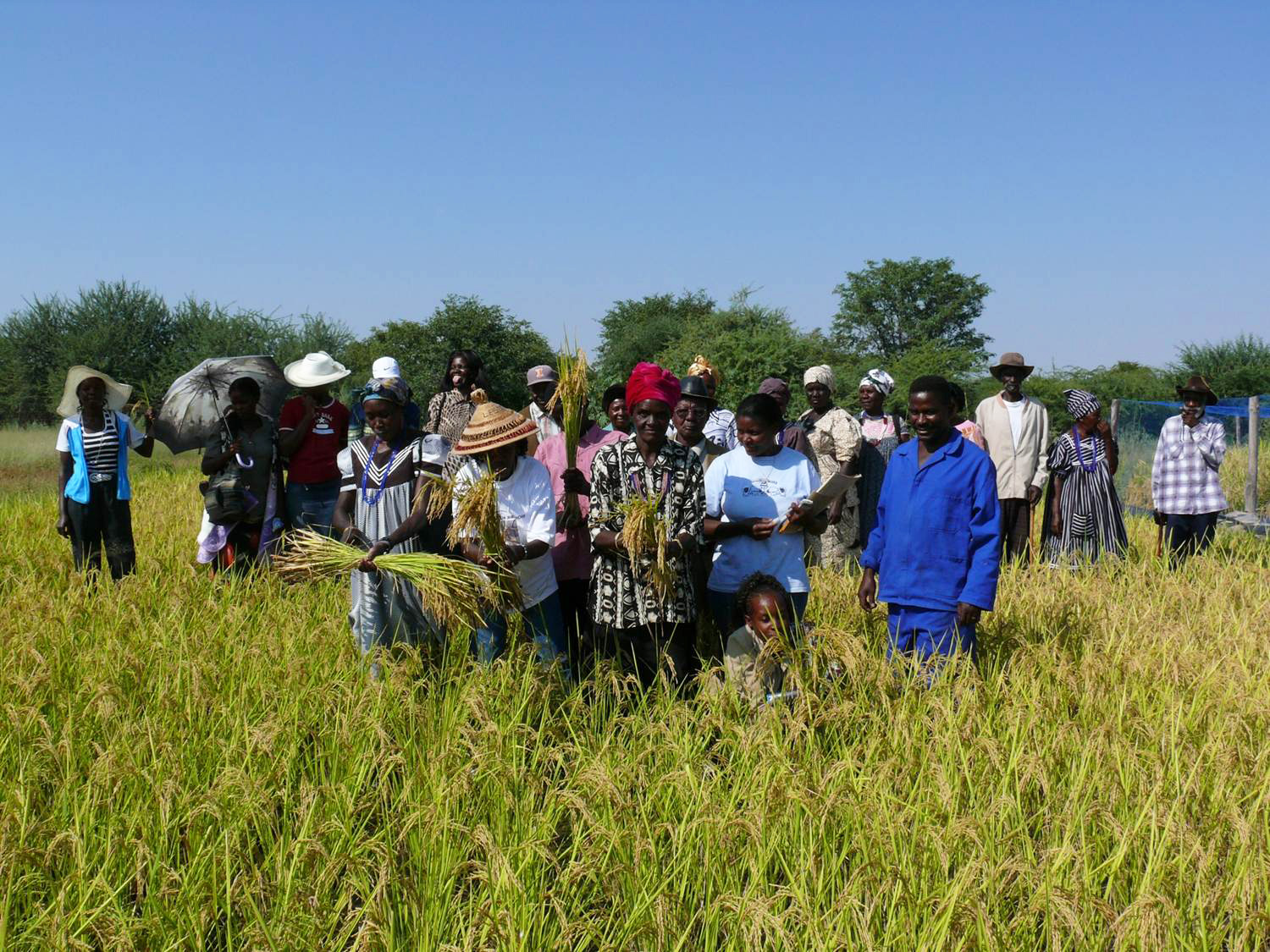
2FyDevelopment Studiesz The methods to understand the change of attitudes and perception by farmers, and socio - economic impacts on farmers through introduction of the rice-pearl millet mixed cropping system are established.
3FyHydrologyz The possible area of mixed-cropping field that does not modify the water environment of seasonal wetlands is estimated based on the water budget/water source analysis.
4FyIntegrated Study of Agricultural and Social Sciencez Namibian researchers and technicians are brought up through the research and farmer participatory activities in the project.
Activity
1-1. Examine the rice-pearl millet mixed cropping system, which can preserve the water resources in semi-arid region and cope with the yearly fluctuation of flooding and drought, by incorporating the feedback from output 2, 3 and 4.
1-2. Examine appropriate cultivation methods to establish the rice-pearl millet mixed cropping system.
1-3. Examine water-saving cultivation techniques to conserve the water resources in seasonal wetlands by using@stable isotope technique.
1-4. Examine measures to deal with environmental stress such as flooding and drought as well as measures to sustain the soil fertility.
2-1. Survey the socio-economic conditions and farm operation of farmers who participate in conducting field demonstration or voluntary trials (baseline survey).
2-2. Secure informed consent by demonstration farmers prior to project activities and share findings from output 1 and 3 through workshops.
2-3. Describe the changes of understanding by demonstration farmers on the contents and purposes of project activities and delineate the points to consider in the process of expansion of the mixed cropping system.
2-4. Classify the environment of farmersf fields from the viewpoint of landscape ecology.
2-5. Examine the sustainability of the mixed cropping system from the socio-economic viewpoint by finding out farmersf decision making criteria to adopt or reject a new cropping system, ways to use the agricultural produce, and the change of perception on wetlands (farm household economy, labour distribution survey).
3-1. Estimate the change of flood (surface) water of seasonal wetland based on regionally-obtained data such as topography map, satellite image and measurement of hydrological conditions.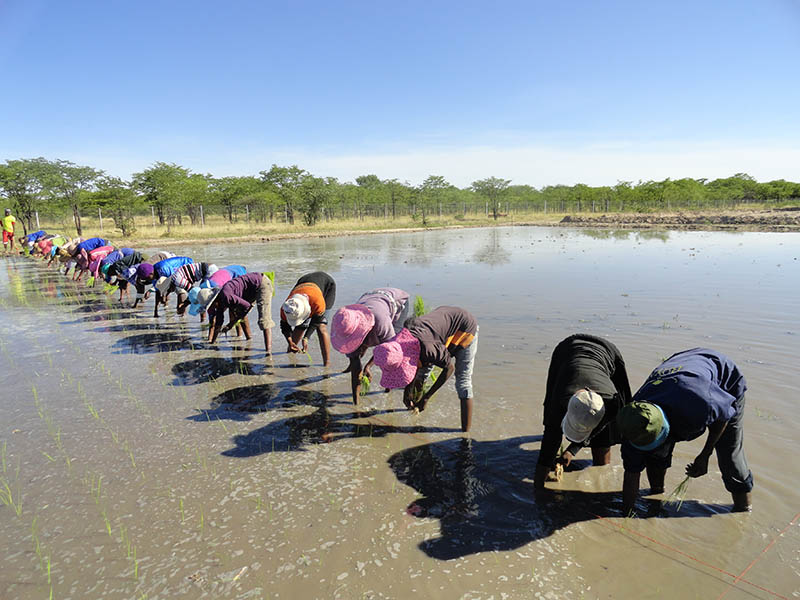
3-2. Analyze the water budget of seasonal wetland based on hydrological data iprecipitation, evapotranspiration, subsurface percolationj
3-3. Analyze the dependence on flood (surface) water of small wetlands that are formed in the farmersf demonstration/trial fields.
4-1. Conduct field demonstration at earnest farmers with small wetlands, on the rice-pearl millet mixed cropping system.
4-2. Support field trials of farmers who participate in trials voluntarily.
4-3. Instruct the studies of Namibian researchers through this joint research to acquire degrees at Kinki University, Nagoya University or the University of Namibia. Carry out continuous, participatory research and extension by the Namibian researchers/technicians on the cropping system through opportunities such as field days in the region.@
Plan of OperationySATREPSz@
Flood- and Drought-Adaptive Cropping Systems to Conserve Water Environments in Semi-arid Regions
Output 1yCrop Sciencez
The rice-pearl millet mixed cropping system, which is adaptable to the yearly fluctuation of flood and drought as well as water-saving, is proposed.
1.1 Examine appropriate cultivation methods to establish the rice-pearl millet mixed cropping system.
1.1.1 Construct the sloped experimental fields with both wetland and upland environments and conduct various cultivation experiments such as planting density and cultivar trials.
1.1.2 Examine a methodology to assess the deep water use efficiency at field and pot experiments.
1.1.3 Compile a mid-term review on basic examination of pot experiments.
1.2 Examine water-saving cultivation techniques by methods including stable isotope technique
1.2.1 Examine water relation of mixed plants under drought- and waterlogging- conditions by pot experiments.
1.2.2 Analyze water sources irain water, wetland water, underground waterj of mixed plants and calculate the dependence on deep water and deep water use efficiency by the stable isotope techniques.
1.2.3 Examine the measurement technique of water use efficiency for the rice-pearl millet mixed cropping system.
1.2.4 Complete the terminal review on field experiments.
1.3 Examine measures to deal with environmental stress such as flood and drought as well as measures to sustain the soil fertility.
1.3.1 Accumulate findings on environmental stress responses of the rice-pearl millet mixed cropping through pot experiments on salt accumulation, drought and low nutrition.
1.3.2 Examine nitrogen use efficiency derived from organic matter for rice-pearl millet mixed cropping.
1.3.3 Compile a mid-term review on basic examination of pot experiments.
1.3.4 Inspect the amount of cow manure to sustain the soil fertility.
1.3.5 Complete the terminal review on field experiments.
Output 2@yDevelopment Studiesz
The methods to understand the change of attitudes and perception by farmers, and socio - economic impacts on farmers through introduction of the rice-pearl millet mixed cropping system are established.
2.1 Survey the socio-economic conditions and farm operation of farmers who participate in conducting field demonstration or voluntary trials (baseline survey).
2.1.1 Comprehend the socio-economic conditions and farm operation of the demonstration/trial farmers.
2.1.2 Compile a mid-term review on the findings.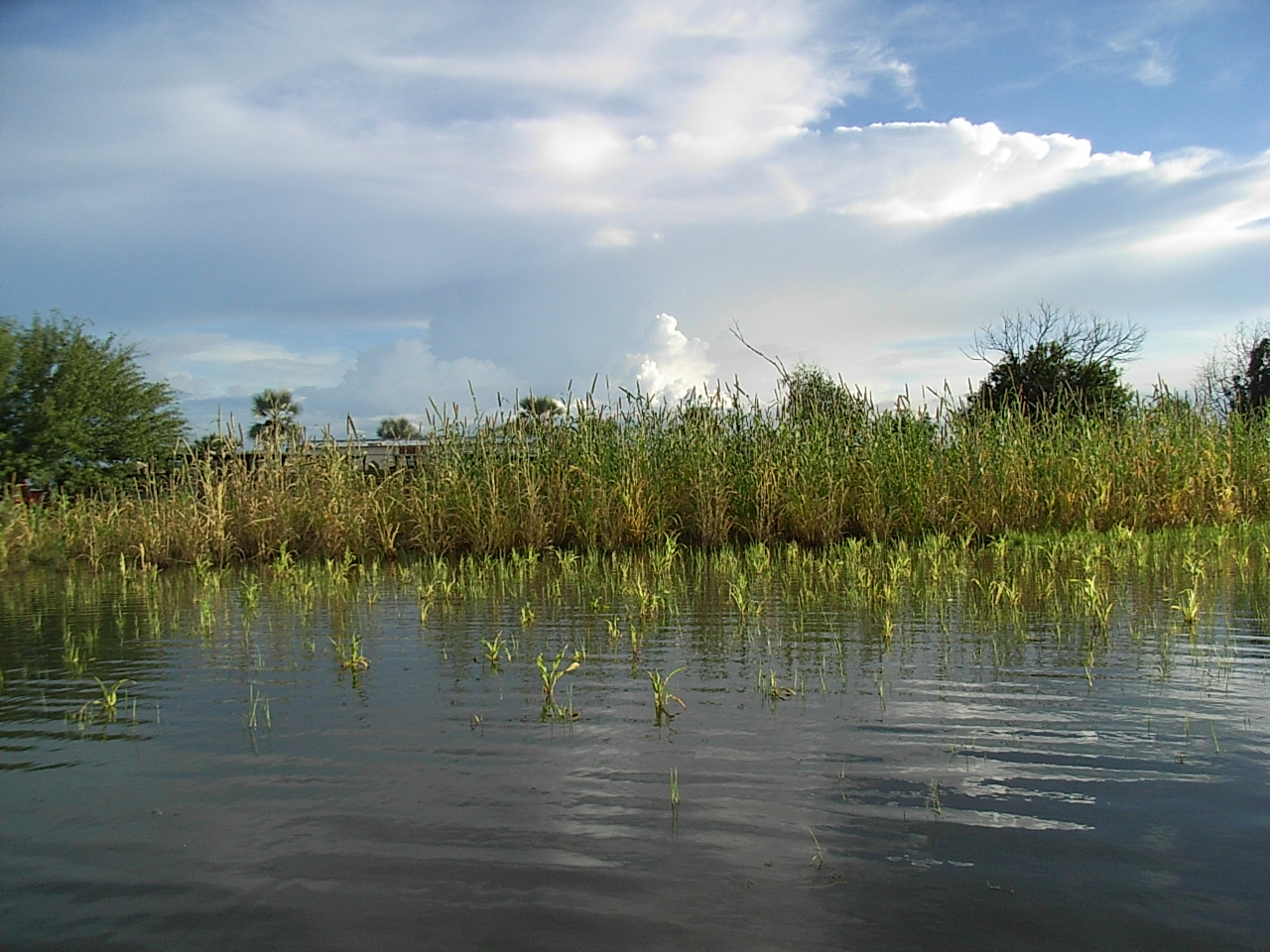
2.1.3 Comprehend the socio-economic conditions and farm operations of farmers that additionally participate in the field demonstration/trial.
2.1.4 Compile the terminal review on the findings.
2.2 Secure informed consent by demonstration farmers prior to project activities and share findings from output 1 and 3 through workshops.
2.2.1 Organize workshops for farmers.
2.3 Describe the changes of understanding by demonstration farmers on the contents and purposes of project activities and delineate the points to consider in the process of expansion of the mixed cropping system.
2.4 Classify the environment of farmersf fields from the viewpoint of landscape ecology.
2.4.1 Conduct an interview survey for criteria of classification on landscape ecology.
2.4.2 Compile a mid-term review on basic findings.
2.4.3 Evaluate the mixed cropping system in farmers' fields from the viewpoint of landscape ecology.
2.5 Examine the sustainability of the mixed cropping system from the socio-economic viewpoint by finding out farmersf decision making criteria to adopt or reject a new cropping system, ways to use the agricultural produce, and the change of perception on wetlands (farm household economy, labor distribution survey).
2.5.1 Evaluate the farm household economy and labor distribution.
2.5.2 Survey the ways to allocate the agricultural produce to different purposes.
2.5.3 Survey the farmers' decision making criteria as to adopt or reject a new cropping systemisetting the criteria and its preliminary assessmentj
2.5.4 Evaluate the impacts on the demonstration/trial farmers.
Output 3yHydrologyz The possible area of mixed-cropping field that does not modify the water environment of seasonal wetlands is estimated based on the water budget/water source analysis.
3.1 Estimate the change of flood (surface) water of seasonal wetland based on regionally-obtained data such as topography map, satellite image and measurement of hydrological conditions.
3.2 Analyze the water budget of seasonal wetland based on hydrological data iprecipitation, evapotranspiration, subsurface percolationj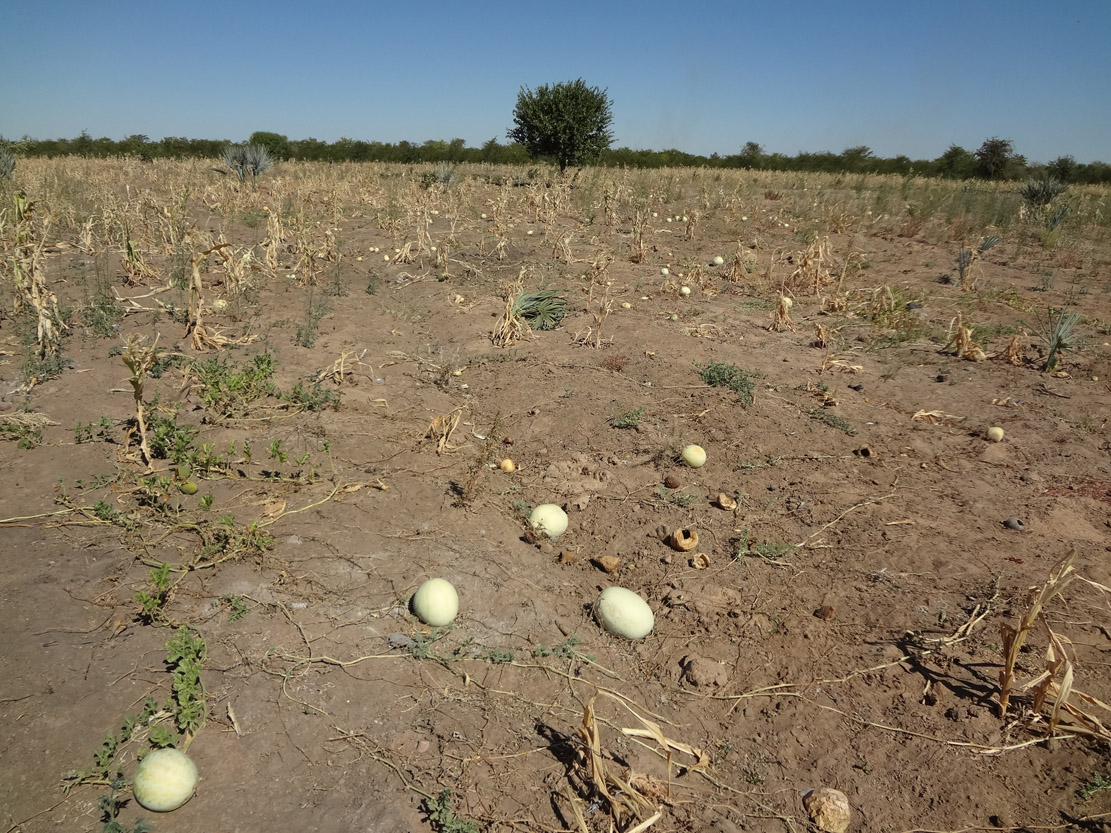
3.2.1 Collect precipitation data using rainfall gauges set up across the overall seasonal wetlands.
3.2.2 Estimate evapotranspiration by the Bowen ratio measurement system set up in the campus of UNAM.
3.2.3 Estimate subsurface percolation by soil infiltration tests in the local fields.
3.3 Analyze the dependence on flood (surface) water of small wetlands that are formed in the farmers' demonstration/trial fields.
3.3.1 Estimate dependence of wetland water on flood water and/or groundwater by the stable isotope technique.
3.3.2 Estimate water age in small wetlands by the analysis of hydrological tracers.
Output 4yIntegrated Study of Agricultural and Social Sciencez The cropping systems proposed by the project are integrated through field activities.
4.1 Conduct field demonstration with committed and hardworking farmers at their small wetlands, on the rice-pearl millet mixed cropping system.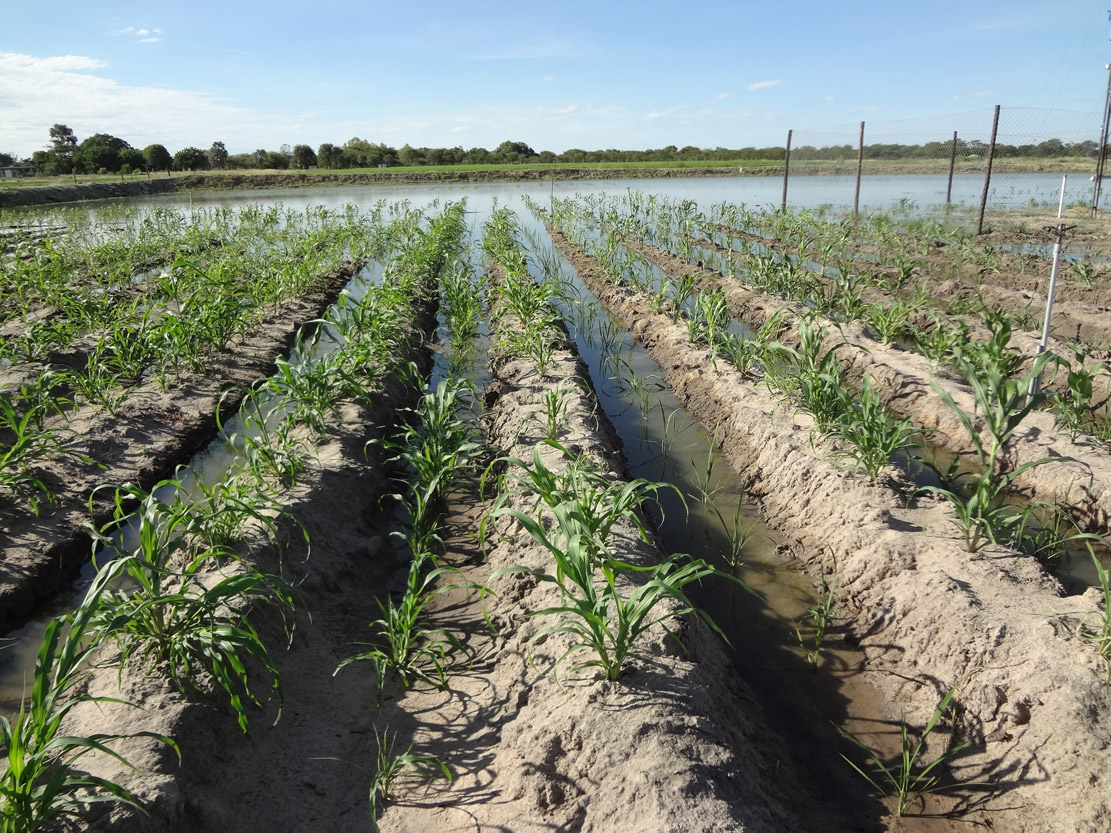
4.1.1 Demonstrate cultivation techniques at about three farmers' fields.
4.1.2 Propose some farming models and expand them at farmers' demonstarion fields.
4.2 Conduct field trials at farmers who participate in trials on the rice-pearl millet mixed cropping system voluntarily.
4.2.1 Try cultivation techniques dependent on farmers' voluntary ideas by providing rice seedlings to farmers.
4.3 Examine the rice-pearl millet mixed cropping system, which can preserve the water resources in semi-arid region and cope with the yearly fluctuation of flood and drought, by incorporating the feedback from output 2 and 3 to output 1.
4.3.1 Propose the farming model of mixed cropping system that can conserve the water environment.
4.4 Carry out participatory research and extension by the Namibian researchers/technicians on the cropping system through opportunities such as field days.
4.4.1 Organize workshop by researchers who attend the technical training courses.
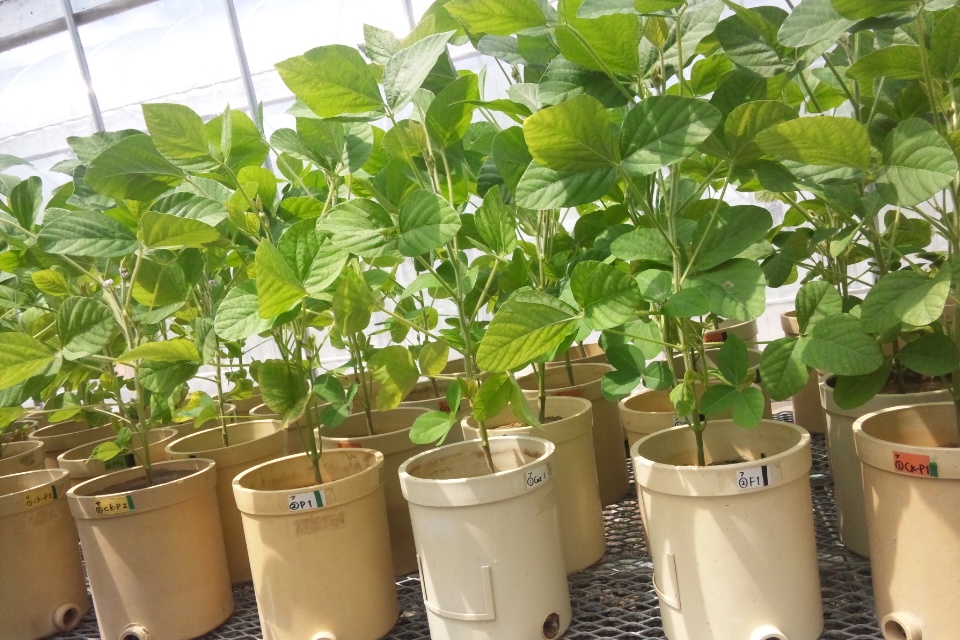 Control of Soybean Nodule Formation by Agronomical Practice
Control of Soybean Nodule Formation by Agronomical Practice
Enhancement of nitrogen fixation by a cultivation technique, not by the genetic improvement such as the use of super-nodulating soybean cultivars, is one of the potential targets to improve soybean yield in the world. We are now trying to establish a new method of enhancing soybean nodulation by a cultivation technique which is a combination of two existing concepts; deep layer fertilization and sub-soiling during soybean growth. The technique utilizes the irregularly shaped soil cracks formed by sub-soiling just before the flowering stage of soybean, and introduces root nodule bacteria to the deep subsoil layer. Through this channel of cracks, aeration is secured to a deep soil layer so that the applied bacteria can form nodules on the soybean roots distributed in the subsoil layer. Sub-soiling during the plant growth period will cut a significant amount of soybean roots; hence, newly emerged deep roots will appear after root cutting. These deep roots should offer the habitat for the nodule bacteria supplied to the deep soil layer together with the copious amount of air through the cracks during the maturing stage. Because nodule growth and/or nitrogen fixation activity usually cease after the flowering stage and/or the early seed development stage, the newly formed root nodule in deep soil after the flowering stage supplies a significant amount of nitrogen to the growing seed resulting in higher soybean yield. The technique ensures that the ventilation channel extends to the deep subsoil layer just before the soybean flowering stage; the dry soil condition during mid- summer after the rainy season help maintaining the soil crack structure, in most cases, for a relatively longer period.
Project SiteF Faculty of Agriculture & Natural Resources, Ogongo Campus,
The University of Namibia and seasonal wetlands in northern Namibia
Target Group: Researchers of Faculty of Agriculture & Natural Resources,
The University of Namibia, and farmers in northern Namibia
Project DurationFJanuary 2012 - December 2016 i5 yearsj
Overall Goal
1. gFlood- and drought-adaptive cropping systemh is disseminated in north-central Namibia to contribute to the food security and cash income of local farmers.
2. g Flood- and drought-adaptive cropping systemh is considered in the northeastern area of Namibia of high rainfall as well as in neighboring countries.
(gFlood- and drought-adaptive cropping systemh: The farming system which secures food crop production by the subsistent farmers in both flood and drought years by mixed cropping of rice and pearl millet.)
Project Purpose
gFlood- and drought-adaptive cropping systemh is proposed that can sustainably preserve the water environment of semi-arid region.
Output
1FyCrop Sciencez The rice-pearl millet mixed cropping system which is balanced with the sustainable water conservation of seasonal wetland in semi-arid region is established.

2FyDevelopment Studiesz The methods to understand the change of attitudes and perception by farmers, and socio - economic impacts on farmers through introduction of the rice-pearl millet mixed cropping system are established.
3FyHydrologyz The possible area of mixed-cropping field that does not modify the water environment of seasonal wetlands is estimated based on the water budget/water source analysis.
4FyIntegrated Study of Agricultural and Social Sciencez Namibian researchers and technicians are brought up through the research and farmer participatory activities in the project.
Activity
1-1. Examine the rice-pearl millet mixed cropping system, which can preserve the water resources in semi-arid region and cope with the yearly fluctuation of flooding and drought, by incorporating the feedback from output 2, 3 and 4.
1-2. Examine appropriate cultivation methods to establish the rice-pearl millet mixed cropping system.
1-3. Examine water-saving cultivation techniques to conserve the water resources in seasonal wetlands by using@stable isotope technique.
1-4. Examine measures to deal with environmental stress such as flooding and drought as well as measures to sustain the soil fertility.
2-1. Survey the socio-economic conditions and farm operation of farmers who participate in conducting field demonstration or voluntary trials (baseline survey).
2-2. Secure informed consent by demonstration farmers prior to project activities and share findings from output 1 and 3 through workshops.
2-3. Describe the changes of understanding by demonstration farmers on the contents and purposes of project activities and delineate the points to consider in the process of expansion of the mixed cropping system.
2-4. Classify the environment of farmersf fields from the viewpoint of landscape ecology.
2-5. Examine the sustainability of the mixed cropping system from the socio-economic viewpoint by finding out farmersf decision making criteria to adopt or reject a new cropping system, ways to use the agricultural produce, and the change of perception on wetlands (farm household economy, labour distribution survey).
3-1. Estimate the change of flood (surface) water of seasonal wetland based on regionally-obtained data such as topography map, satellite image and measurement of hydrological conditions.
3-2. Analyze the water budget of seasonal wetland based on hydrological data iprecipitation, evapotranspiration, subsurface percolationj
3-3. Analyze the dependence on flood (surface) water of small wetlands that are formed in the farmersf demonstration/trial fields.
4-1. Conduct field demonstration at earnest farmers with small wetlands, on the rice-pearl millet mixed cropping system.
4-2. Support field trials of farmers who participate in trials voluntarily.
4-3. Instruct the studies of Namibian researchers through this joint research to acquire degrees at Kinki University, Nagoya University or the University of Namibia. Carry out continuous, participatory research and extension by the Namibian researchers/technicians on the cropping system through opportunities such as field days in the region.@
Plan of OperationySATREPSz@
Flood- and Drought-Adaptive Cropping Systems to Conserve Water Environments in Semi-arid Regions
Output 1yCrop Sciencez
The rice-pearl millet mixed cropping system, which is adaptable to the yearly fluctuation of flood and drought as well as water-saving, is proposed.
1.1 Examine appropriate cultivation methods to establish the rice-pearl millet mixed cropping system.
1.1.1 Construct the sloped experimental fields with both wetland and upland environments and conduct various cultivation experiments such as planting density and cultivar trials.
1.1.2 Examine a methodology to assess the deep water use efficiency at field and pot experiments.
1.1.3 Compile a mid-term review on basic examination of pot experiments.
1.2 Examine water-saving cultivation techniques by methods including stable isotope technique
1.2.1 Examine water relation of mixed plants under drought- and waterlogging- conditions by pot experiments.
1.2.2 Analyze water sources irain water, wetland water, underground waterj of mixed plants and calculate the dependence on deep water and deep water use efficiency by the stable isotope techniques.
1.2.3 Examine the measurement technique of water use efficiency for the rice-pearl millet mixed cropping system.
1.2.4 Complete the terminal review on field experiments.
1.3 Examine measures to deal with environmental stress such as flood and drought as well as measures to sustain the soil fertility.
1.3.1 Accumulate findings on environmental stress responses of the rice-pearl millet mixed cropping through pot experiments on salt accumulation, drought and low nutrition.
1.3.2 Examine nitrogen use efficiency derived from organic matter for rice-pearl millet mixed cropping.
1.3.3 Compile a mid-term review on basic examination of pot experiments.
1.3.4 Inspect the amount of cow manure to sustain the soil fertility.
1.3.5 Complete the terminal review on field experiments.
Output 2@yDevelopment Studiesz
The methods to understand the change of attitudes and perception by farmers, and socio - economic impacts on farmers through introduction of the rice-pearl millet mixed cropping system are established.
2.1 Survey the socio-economic conditions and farm operation of farmers who participate in conducting field demonstration or voluntary trials (baseline survey).
2.1.1 Comprehend the socio-economic conditions and farm operation of the demonstration/trial farmers.
2.1.2 Compile a mid-term review on the findings.
2.1.3 Comprehend the socio-economic conditions and farm operations of farmers that additionally participate in the field demonstration/trial.
2.1.4 Compile the terminal review on the findings.
2.2 Secure informed consent by demonstration farmers prior to project activities and share findings from output 1 and 3 through workshops.
2.2.1 Organize workshops for farmers.
2.3 Describe the changes of understanding by demonstration farmers on the contents and purposes of project activities and delineate the points to consider in the process of expansion of the mixed cropping system.
2.4 Classify the environment of farmersf fields from the viewpoint of landscape ecology.
2.4.1 Conduct an interview survey for criteria of classification on landscape ecology.
2.4.2 Compile a mid-term review on basic findings.
2.4.3 Evaluate the mixed cropping system in farmers' fields from the viewpoint of landscape ecology.
2.5 Examine the sustainability of the mixed cropping system from the socio-economic viewpoint by finding out farmersf decision making criteria to adopt or reject a new cropping system, ways to use the agricultural produce, and the change of perception on wetlands (farm household economy, labor distribution survey).
2.5.1 Evaluate the farm household economy and labor distribution.
2.5.2 Survey the ways to allocate the agricultural produce to different purposes.
2.5.3 Survey the farmers' decision making criteria as to adopt or reject a new cropping systemisetting the criteria and its preliminary assessmentj
2.5.4 Evaluate the impacts on the demonstration/trial farmers.
Output 3yHydrologyz The possible area of mixed-cropping field that does not modify the water environment of seasonal wetlands is estimated based on the water budget/water source analysis.
3.1 Estimate the change of flood (surface) water of seasonal wetland based on regionally-obtained data such as topography map, satellite image and measurement of hydrological conditions.
3.2 Analyze the water budget of seasonal wetland based on hydrological data iprecipitation, evapotranspiration, subsurface percolationj
3.2.1 Collect precipitation data using rainfall gauges set up across the overall seasonal wetlands.
3.2.2 Estimate evapotranspiration by the Bowen ratio measurement system set up in the campus of UNAM.
3.2.3 Estimate subsurface percolation by soil infiltration tests in the local fields.
3.3 Analyze the dependence on flood (surface) water of small wetlands that are formed in the farmers' demonstration/trial fields.
3.3.1 Estimate dependence of wetland water on flood water and/or groundwater by the stable isotope technique.
3.3.2 Estimate water age in small wetlands by the analysis of hydrological tracers.
Output 4yIntegrated Study of Agricultural and Social Sciencez The cropping systems proposed by the project are integrated through field activities.
4.1 Conduct field demonstration with committed and hardworking farmers at their small wetlands, on the rice-pearl millet mixed cropping system.
4.1.1 Demonstrate cultivation techniques at about three farmers' fields.
4.1.2 Propose some farming models and expand them at farmers' demonstarion fields.
4.2 Conduct field trials at farmers who participate in trials on the rice-pearl millet mixed cropping system voluntarily.
4.2.1 Try cultivation techniques dependent on farmers' voluntary ideas by providing rice seedlings to farmers.
4.3 Examine the rice-pearl millet mixed cropping system, which can preserve the water resources in semi-arid region and cope with the yearly fluctuation of flood and drought, by incorporating the feedback from output 2 and 3 to output 1.
4.3.1 Propose the farming model of mixed cropping system that can conserve the water environment.
4.4 Carry out participatory research and extension by the Namibian researchers/technicians on the cropping system through opportunities such as field days.
4.4.1 Organize workshop by researchers who attend the technical training courses.
Enhancement of nitrogen fixation by a cultivation technique, not by the genetic improvement such as the use of super-nodulating soybean cultivars, is one of the potential targets to improve soybean yield in the world. We are now trying to establish a new method of enhancing soybean nodulation by a cultivation technique which is a combination of two existing concepts; deep layer fertilization and sub-soiling during soybean growth. The technique utilizes the irregularly shaped soil cracks formed by sub-soiling just before the flowering stage of soybean, and introduces root nodule bacteria to the deep subsoil layer. Through this channel of cracks, aeration is secured to a deep soil layer so that the applied bacteria can form nodules on the soybean roots distributed in the subsoil layer. Sub-soiling during the plant growth period will cut a significant amount of soybean roots; hence, newly emerged deep roots will appear after root cutting. These deep roots should offer the habitat for the nodule bacteria supplied to the deep soil layer together with the copious amount of air through the cracks during the maturing stage. Because nodule growth and/or nitrogen fixation activity usually cease after the flowering stage and/or the early seed development stage, the newly formed root nodule in deep soil after the flowering stage supplies a significant amount of nitrogen to the growing seed resulting in higher soybean yield. The technique ensures that the ventilation channel extends to the deep subsoil layer just before the soybean flowering stage; the dry soil condition during mid- summer after the rainy season help maintaining the soil crack structure, in most cases, for a relatively longer period.